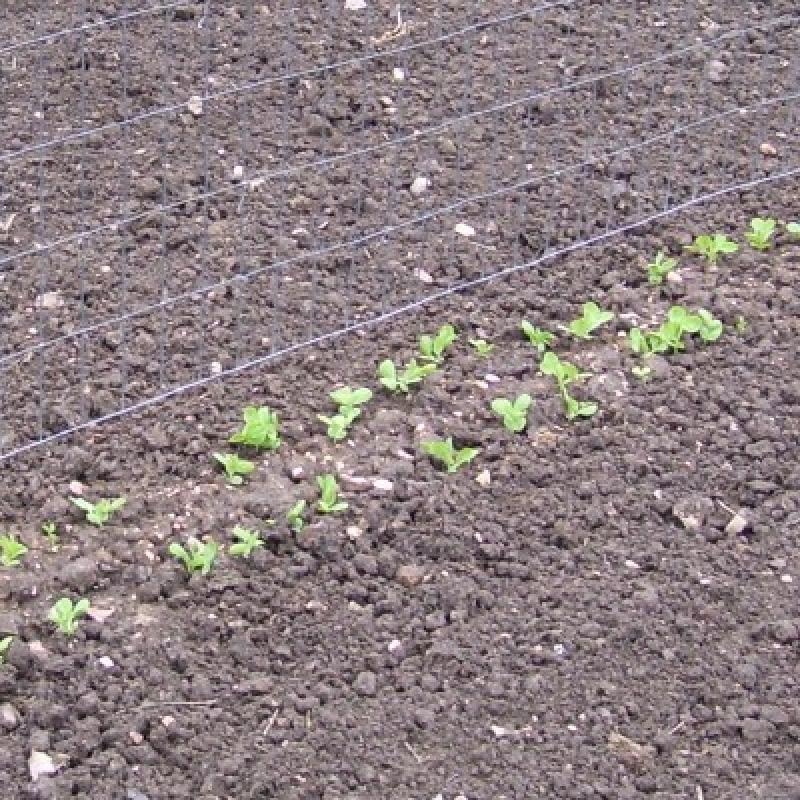
The Garden Chronicles - Week 2


It turned cool this week and the asparagus slowed down. It's still coming up, but not explosively. It actually frosted lightly on a couple of nights, but the apple blossoms seem to have survived. Hopefully the frost is over for good now. I'm ready for steady, dependable warmth.
I staked out some rows and planted the first small batches of beets, turnips, and two kinds of carrots, along with some onions and a small sample of red potatoes. I usually don't bother with potatoes, but I thought I'd throw a few in this year just for the fun of it (literally a few, just one small bag of seed potatoes).
I also planted some kohlrabi (German turnips?). I don't think I've ever had them before, but I'm going to give them a try. I've read that they attract fewer bugs than other cole crops, so I'm hoping that pans out. Bugs are the reason I gave up growing broccoli and cabbage years ago. I can't stand the worms, and I'm not interested in using enough pesticide to control them. If the kohlrabi works out, I'll make it a yearly thing.

Polly.

Cloudy, cool, and wet.

Redbud still blooming.

Rows staked out.

The peas are easy to see now.


Apple blossoms.



This is a seed starting planter I made out of scrap materials I had on hand.

It holds one of those store-bought trays for 18 seed pots.

I'll try starting my summer transplants in it this year.

I covered it with floating row cover to hopefully protect seedlings from pounding rain, while allowing 90% of sunlight through. It's pretty flimsy stuff, and I don't know how well it'll work, but that's what I'm starting with.

See you next week.
Note -- Camera user snafu. The date stamps should read 4/17, not 4/15.

Love these articles.
It may seem like a lot more work but if you plant Marigolds around the perimeter of your garden it will keep a lot of bugs away.
Thanks, Pat. I've heard that before, but never tried it. Does it really work?
I've seen marigolds planted around the edges of vegetable gardens, but I always heard it was to repel deer.
It's been a long time since I had a garden but it worked for me. I've heard that roses do the same thing.
I had a veggie garden for over 20 years, with lots of different veggies. I would rotate their planting so that I could keep the soil changed up. Each year I would plant new veggies to see which ones would work good where I lived and the soil. And those that did well gave us a change of taste and varied my cooking. My garden was 40 by 80 feet. So I had plenty of room to have a very varied selection of plants. The one veggie that didn't grow well was corn. For some reason it did not do well there. But, lots of others did very well.
And after harvesting the various veggies and freezing and canning some, we put up a little stand in the front yard and sold the extra. Gave us a bit of extra spending money and to by more seeds with.
That's awesome, RW.
It's a shame you couldn't grow corn. I always try to grow enough to put about 150 ears in the freezer.
That reminds me. If anyone is planting corn this year and doesn't already have their seed, then allow me to suggest going to Gurneys.com and ordering a variety called 'Gotta have it'. It's the best corn for freezing that I've ever tried. The kernels actually stay decently firm and crisp after freezing, not soft and mushy like some other varieties. That's been my experience with it, at least. I just love it. It's what I'll be growing this year.
Having a garden that size was a lot of work, but, I love gardens and as the owner of my own business, working in the garden really helped release the stress.
In addition to the veggie garden, I grew green seedless grapes. I gave several pounds worth to a friend as I had a bumper crop that year and far more then I could use, eat or sell before they started to go bad. To my surprise, he offered to relay me for the grapes. Two gallons of green grape wine! I had never heard of green grape wine before, and I am not as wine drinker, as it gives me serious headaches, but, I tried some to see what it tasted like and it was was dang good! So I divided it into several small containers and gave it ways as Christmas gifts. Everyone loved it. Lots of goodie points for me that Christmas.
I've thought about putting in some grapes. I even bought a couple of books on growing them, pruning them, and making wine. Haven't done it yet, though.
I built a small trellis and just planted one grape plant, as I didn't really want too many grapes. Mom-ma Mia! That one plant turned into a vine that engulfed the trellis, and I had to build an addition to that one to accommodate the vine, and even then the vines grew out into the yard with in only a few days. So I had to add a third trellis to get the grapes off the grass. And the grapes were huge! Some were almost an inch long and a half inch in diameter. That was for their second year. The next year they were not that abundant or as big, but, the fourth year they were huge again and over flowing. So it seemed that the pattern was every other year of abundance, which made it easy for planning.
Funny thing is.....I have a green thumb for gardens, but, a totally Grim Reaper thumb for house plants. No matter what kind of plant I had in the house died within weeks. Even the green false ivy I put up around the window in my dining room turned yellow and shriveled up and fell apart.
So....I left the house plants to someone who could give them a good home and stuck to my garden. (grin)
That's a big garden !
Yes it was. But, I gave the plants good spacing and room to grow well. Some veggies would get very large. Like my cabbages, the heads were as big as a basket ball. The beef steak tomatoes were about 4 inches in diameter. Their vines were very large and took up a lot of room. Nearly all the plants were huge and so was their fruit. I had a smaller garden the year before, about half the size, and the veggie and their plants didn't grow very well and tended to crowd together. So that is why I made the garden larger so I could give the plants more space to grow. My ducks and chickens helped with the worm issues where there were any, and the chickens scratching helped till the soil around the plants. Everyone had to earn their keep. (hee hee)
I plant marigolds and nasturtiums (had to get the seed pack so I could spell it) they help with bugs, but I still have to spray and dust a little. I had a bad problem with whiteflies a few years ago and nasturtiums seemed to help.
Dobermans handle groundhogs but they sample things and the fence that keeps dogs in keeps deer out
kohlrabi is good but don't let it get too big or it will be tough
I hope to move my tomatoes from window sill with grow lights to the greenhouse this week and repot some of them in bigger pots
I wouldn't mind having a little greenhouse in the spring. I don't know if I'd have much use for it the rest of the year, but every spring it crosses my mind.
Do you know if kohlrabi has a problem with cabbage worms?
Nothing has bothered my kohlrabi.
I got my greenhouse on sale at Harbor Freight. I built a base for it and added more supports. It is OK, hopefully I can build a garage attached to the house with a greenhouse/sunroom.
It would certainly be cool to be able to walk out into it from the house.
Bugs destroyed my rhubarb crop a few years ago. I got to fix one pan of rhubarb crumble, and that was the last I was able to harvest.
Bugs are the reason I won't be growing pie pumpkins for the first time in years.
I fought the squash bugs, and the squash bugs won.
My zucchini and butternut squash still get squash bugs on them, but in quantities I can handle. My pumpkins were almost always a lost cause, though. I could hardly ever keep the vines alive long enough for the pumpkins to reach full maturity. I'd pick them and they'd be rotting in just a couple of weeks. I'm going to take a break from that for a while. It'll be canned pumpkin for pies this Thanksgiving. Or maybe I'll use some of my butternut squash instead. It's pretty darn close to pumpkin.
I never could get pumpkins to produce. The vines always looked healthy, and bloomed, and then...nothing. No fruit. I don't remember seeing any bugs on them though. I was growing them more for jack o'lanterns than food, at my son's request.
Libby's is perfectly acceptable for pumpkin pie, and a lot less work.
I usually grow spaghetti squash, and squash bugs like them, too, but they've always produced well, anyway.
I can't figure out which is stranger, that they'd bloom but not produce, or that you didn't see any squash bugs on them. That would be like a dream come true for me (the no bug part, that is).
I can't imagine what would cause the blooms not to set fruit. It's hard to imagine that there wouldn't be any pollinating insects around at all. Maybe you had some seeds with bad genetics that wouldn't make both male and female flowers? Did it happen more than once?
I only remember trying once. There are a lot of bees around my house - lots of flowering trees and shrubs to tempt them. It was a hybrid type - ghost pumpkins. So maybe it was bad genes.
My worst disappointment was trying to grow sugar baby watermelons. They looked so good until I cut into them. They were almost all rind - hardly any flesh at all. I was looking forward to a good watermelon.
I've been disappointed by sugar babies in the past as well.
I think I'm going to let a couple crimson sweets fill up that corner by the blackberries later on this summer. I've done that before and it worked out fine. After the berries are done, the vines can just ramble through there all they want.
The #1 thing I learned from my Grandmother about gardening....when things started to blossom you never worked the garden in the early morning or late afternoon....that is when the bees like to shop for nectar from all the blossoms. And after a few bee stings working in my own garden in the early morning I took her advise to heart. Owwweee!!
Bees buzz around my yard from sunup to sundown. There's no good daylight hour to avoid them.
I was an armature beekeeper for several years, and had my hives way out in the back of my back yard, which was 400 ft deep. So the bees had ample access to the garden and other sources of nectar nearby. They liked to hit the garden blossoms while they were fresh early in the morning and took off for their other sources. I only had three small hives, and gave some of the honey and combs to my Grandmother as she loved the honey and to eat the combs.
I myself don't like honey, but, members of my family did, and the bees helped keep my garden well pollinated. My friend was also a beekeeper and helped me with harvesting the hives, and preparing them for winter and other necessary things to keep the hives and bees healthy. The bees knew me and I never had to use a net or smoker as they never bothered me. They just flew around me to do their thing while I worked.
I planted garlic between each of my tomato plants, as well as some of the other veggie. The garlic kept the bugs away nicely so I didn't have to use any sprays or repellents. However, no matter what I tried, it did not stop the gofers from eating the roots off of my cabbages once they were well grown and ready to harvest.

Deer used to clean out my garden, until my dad put up a fence for me. Now they go after my flower beds, instead Rabbits were a problem, too, but my dog takes care of those.
Rabbits were a problem, too, but my dog takes care of those.
The rhubarb was doing so well, and then I noticed some bugs near the roots. I used Sevin Dust on them, but it didn't do any good - those bugs ate right through the stalks and killed the whole patch.
When I lived in No Virginia I had a small garden in the backyard. I grew herbs in a vertical garden and planted garlic them as well, so the bugs didn't really bother them.
But, there were groundhogs that came over from the neighbors yard to feast on my garden sprouts and ate everything in sight all in one night.
So I checked with the local AG-dept and asked what I could use to keep the rascals away. He said to spray ammonia all around the garden, about a foot away from the edge of the garden so that it would not leach into the garden and kill the plants. I also put a small fence around the garden, but, it did not keep the groundhogs away.
After I sprayed with the ammonia, which the AG agent said most all, if not all, animals of any kind would not go near it, the groundhogs disappeared from my yard. Then they decided to move under the house! So I got some ammonia balls threw them under the house from the air vents in the foundation, and they ran like their tails were on fire and I never saw them again.
Wolf urine repels a long list of critters looking for easy eats in a garden. It sounds gross, but it works.
I have no worries about critters, including humans getting into my garden.
My garden protector is quite adamant about protecting my veggies
Actually I don't have a garden. I hoed too damn many potatoes and cut enough lettuce to ignore and never think of a garden again.
The photo of this wolf was taken in NE Minnesota where I grew up. We used to see them quite often.
Sorry D had to get it out of my system.
Feel free to delete it.
Lol. No worries, Kav.
Thanks D,
Actually when thinking about it I do have a garden, it's natures garden. I've harvested wild rice for years and years. We call in Manomiin (the food that grows on water) It's harvested in late august in the rivers and lakes of MN.
Here is a photo of it being harvested in Red Lake MN.
I would live to have tried some of that rice. No one can grow things like Mother Earth.
HA! I thought you were talking about Wiki!
I was also expecting a pic of Wiki.
I bet Wiki could be a better garden protector than that wolf, and scare that wolf off as well. (grin)
So was I!
Now that is a guard dog!
Being a person who once had and tended a garden but no long has the opportunity, I want to thank you for these articles, and especially the photos, due to which I can enjoy vicariously what once brought me peace of mind and pleasure. I am going to consider planting a small balcony vegetable garden in the near future, due to the fact that we may well be moving to new apartment in June. I know I'll get lots of good advice, because my wife grew up on a farm, and really knows her vegetables.
I'm very glad to hear that you're enjoying this little project of mine, Buzz. That was really all I was hoping for, that other people would enjoy it with me.
I guarantee that you can grow a tomato plant or two on a balcony in big flower pots. You'll have to prune them, though, to keep them smaller and more manageable than they would otherwise be (unless you have a huge balcony, that is). If you don't know how to prune tomatoes, I'll be showing how in one of these blog posts later on this summer when I'm doing my own. It's pretty darn easy, once you've learned what to pinch off as they grow, and what not to.
Toss in a few smaller flower pots with lettuce growing in them, and you could have yourself a little balcony salad garden.
I appreciate your advice. I was always thinking about tomatoes - both regular size and cherry/grape size.
I've been meaning to ask, but keep forgetting, are the pictures sized okay for everyone's screens? They look fine on my old desktop, but appear smaller on my tablet. It's easy to zoom them with a tablet, though.
Right now I'm resizing them to 25% of how they come off the camera. I didn't want to have a bunch of huge file sizes that might bog down page loading for some of us. I can certainly post them larger going forward, though, if anyone thinks I should.
They seem to be sized perfectly.
They look good on mine.
They look fine on mine.
Excellent size - needs no change.
Great. Thanks guys.
Sprouts. I see sprouts. Haha
Coming along. We finally had a little bit of rain last night. I don't think we have had rain for about a month. Was even under a burn ban.
I just realized I've already goofed up the date stamps. Sheesh. Second week in.
I was playing around with the camera settings a few days ago and I must have changed the date without realizing it. The pictures are supposed to say 4/17, not 4/15. They were taken Friday, not Wednesday.
Not a huge deal or anything. Still, the one time I actually want to use date stamps and...ugh. At least now I know to double check in the future.
I saw earlier that his week's COVID-19 death count hit 40,000, almost doubling from last week, and that the confirmed cases nationwide keep skyrocketing, even with social distancing and stay at home orders in place for weeks.
I'm starting to wonder if things might not turn out quite like the projections are suggesting. I mean, a flattened and diminishing curve resulting in about 60,000 deaths by August, and then it'll be mostly over? Really? We aren't leveling this thing off very much at all, nationally. If the current death rate doesn't drop fast, and I mean fast, then we could hit 60,000 by the end of April.
I can't believe I'm saying this, but things could actually deteriorate pretty rapidly this summer. I'm not much of a conspiracy theorist, or a doomsday-minded person, but the possibility for some seriously troubled times feels greater than it ever has before in my life. The economy might really go off a cliff, supermarket supply chains and all.
I'm starting to think about tilling up some ground outside the fence and putting in a few more things, like more tomatoes and green beans. The kind of stuff that produces steadily and can be eaten over an extended period of time. Carrots, too. You can just leave them in the ground until you want them. Maybe even some okra. That stuff is prolific, and okra and tomatoes isn't such a bad dish. I wasn't going to grow any this year, but I still have some seed left over from last year. It's more than likely still good.
What do you guys think? Are any of you with gardens (or even just back yards) starting to think about planting a little food insurance for this summer? I wasn't until today. Not in any serious way. But, boy howdy, I am now.
I had thought of a "victory garden" of sorts, but I'd have to build more raised beds, and I'm not quite sure how to go about it. The ones I have were here when I bought my house. The soil in my yard consists of a very thin layer of topsoil over rock (in some places, there is bare rock), so it's not good for growing veggies. I have a hard time growing grass.
Container gardens, maybe? I have some herbs growing in planters on my deck.
Yeah, containers could work. I know you can grow things like tomatoes, peppers, and cucumbers in 5 gallon buckets. Probably okra, too. Beans might even work, 4 or 5 plants per bucket.
I don't eat tomatoes or okra, but I'd eat the others. What about potatoes? I've never grown them. Would they do well in a deep enough planter?
You don't like gumbo? Oh, the humanity!
But, yeah, potatoes can be grown in containers. I'm pretty sure I've watched a YouTube video of some guy growing them in buckets.
There's probably a lot of stuff on YouTube about container gardening. It could be a good resource.
A high school classmate runs a program with the West Virginia National Guard encouraging people to garden. Gardening and the military seemed like an odd combo to me, but they really seem to have a great program going. She does aeroponics, container gardens, etc. I'm sure she could give me some advice. She loves this stuff.
I imagine the biggest pain with containers would be getting all the dirt. I'd probably still go with that, though. There's got to be some dirt around there somewhere. A creek or river bank within driving distance would be primo. Bottomland dirt is some seriously good stuff, unless there's a lot of pollution in the watershed.
Hydroponics and aeroponics require materials like netpots, growing media, pipes, tanks, pumps, timers, feed lines, and nozzles. Not to mention a good supply of nutrient solution. I was into that stuff in the past, and it can get very expensive, very quickly. It's still awfully fun, though. Almost space-age.
A military gardening program does seem odd. But yeah, if you have a friend involved with that, then she might even be able to get you some supplies. Containers and seeds maybe?
They call it "Patriot Guardens". IIRC, it started as a health initiative to get West Virginians to eat healthier by growing some of their own food. She acts as an advisor, teaching the Guard how to garden, and they then hold workshops to teach interested citizens. They also provide manpower to build garden beds, set up aeroponic gardens, and care for the plants.
Just visited their Facebook page, and they recommend large cardboard boxes as biodegradable planters. Might have to try that.
Guardens. Ha. That's clever.
I don't understand how cardboard boxes can be used for containers, though. Even with a trash bag or something lining them, wouldn't they still get wet and fall apart from the rain?
Hmm. Maybe not if the liner was big enough to cover both the inside and the outside. I guess that might work.
Obviously it must work, or they wouldn't be recommending it. I might have to look that up and see how they do it.
I looked it up in more detail. You're supposed to plant the whole box in the ground after your plants get started, so the sides don't have to hold up for long. So it's not meant to a season-long container. Darn. I thought I was onto something.
They just use them for starter pots? That seems like more trouble than it's worth. They'd still get damp and fall apart, wouldn't they? And unless someone has a bunch of really small boxes, they'd be a lot bigger and more of a hassle than they need to be. Too much dirt.
I often just use red solo cups. Drill a few holes in the bottom, put them in a container of some kind to keep them upright and to catch the runoff, and voila. They can be washed and reused year after year.
Four of the 9 oz. cups fit nicely in old ice cream pails, which also last for years, and even have handles for moving them around easily.
I can see maybe doing it that way, if you're starting some seeds that can be put out pretty quickly, before the sides collapse. Then the box just becomes part of the soil, and you don't have to risk disturbing the roots moving them from the starter pot to the ground.
I use the biodegradable ones that have a disc of peat moss. The planters become part of my garden soil. But I like your Solo cup idea, too.
The roots aren't disturbed much at all when transplanting from the cups. As long as the soil is damp, you can squeeze the sides a couple of times, turn it upside down, and the whole thing just falls out like a solid plug. The root mass stays intact.
Do the discs you use have netting around them? I think I've tried those before and they weren't really big enough for my purposes. I don't think I liked the netting, either (if they're what I'm thinking of, that is). It seems like it lasted a long time, and I kept having to pick up little net bags out of the tilled soil the next year. I think I tried them for lettuce.
The disks don't have netting. They swell when watered, but not very big.
I can't find Lantanna any yet. Not surprised under the circumstances.
We are pretty sure about the gardens and the patio pots now as far as bulbs and perennials that are already up and blooming so it's time to replant the vacant spots and hope we don't hit any late bulbs.
The first Black eyed Susans are opening in mass, to join mounds of Coreopsis and Dahlia in the garden and in pots,
African daisys survived the winter as well as two large Echinacea
and several Gerbera daisies.
Today was the first day in the 90's which killed some potato plants and wilted quite a few flowers.